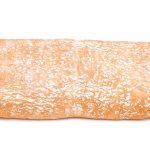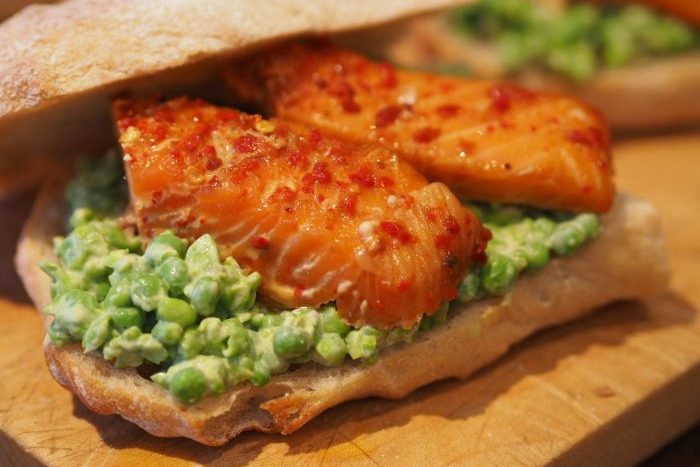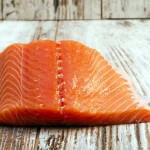Here’s a tasty way to eat a portion of oily fish. A delicious healthy meal.....with a difference and simple enough for children to make for themselves.
Skills Check
Follow a recipe; follow food safety & hygiene rules; tidy away; use weighing scales; use measuring spoons and cups; cut using bridge/claw technique safely; use a colander; mash; spread; use the kettle (with adult supervision); season to taste.
Equipment
Weighing scales; small bowl, kettle, colander, fork, measuring spoons, spoon, chopping board, bread knife.
Allergens (Please note the allergens listed are indicative only. Allergens vary depending on brand; check the labels on the products you use)
Gluten | Milk | Fish | May contain soya
Ingredients (serves 2):
- 1 large ciabatta loaf
- 1 x 180 g packet of pre-cooked salmon (we used sweet chilli flavour, but you could use plain)
- 200 g frozen peas
- 1 tbsp reduced fat crème fraiche
- Black pepper, to taste
Method
- Place the peas in a bowl and pour over boiling water. Leave for 5 minutes, drain and run them under the cold water. Leave them to cool.
- When the peas are dry, add the crème fraiche and roughly mash them together with a fork. Add pepper to taste.
- Cut the ciabatta in half length ways, and spread the smashed up peas on the bottom half.
- Place the pre-cooked salmon on top and serve as an open sandwich.
So thinking about Smashing Salmon Sarnie ...

Salmon is an excellent source of protein, as well as a range of vitamins and minerals. It is an oily fish and so contains high levels of omega-3 fatty acids. These are healthy fats and are very good for our bodies.
Peas are legumes and like other legumes (beans and lentils) they are packed with protein and fibre. They are also low in calories and fat, and are a good source of vitamins and minerals.
Nutritional Information
| Energy | 2379kJ/568kcal | 28% | |
| High | Fat | 23.0g | 33% |
| Med | Saturates | 5.6g | 28% |
| Low | Sugars | 9.2g | 10% |
| Low | Salt | 0.84g | 14% |
per 288g serving
% of an adult's reference intake
Typical values per 100g: Energy 826kJ / 197kcal
Notes
A traffic light system is used on nutrition labels to make it easier to see which foods and drinks are lower in calories, fat, sugar and salt. Try and choose more ‘greens’ and ‘ambers’ and fewer ‘reds’, and stick to smaller portions of ‘reds’.
Just because a recipe or a food has a red traffic light doesn’t mean you shouldn’t eat it. Understanding why a food or recipe might have a red light can be helpful. For example oily fish is high in total fat and so any recipe containing oily fish is likely to be ‘red’ for fat. But it is recommended that we eat oily fish at least once a week because the type of fat it contains is beneficial for our health.
% Reference Intakes are also shown. Reference Intakes are guidelines about the approximate amount of particular nutrients and energy required for a healthy diet (based on an average-sized woman doing an average amount of physical activity). Most children will require less than these Reference Intakes. The contribution of one serving of a food or drink to the Reference Intake for each nutrient is expressed as a percentage.




